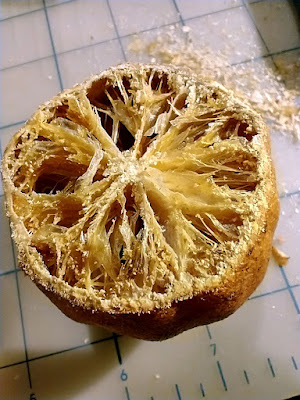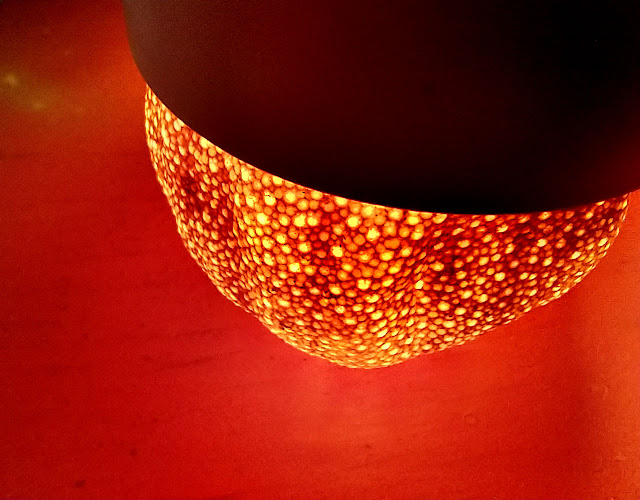I accidentally recreated a 70s crafting fad. And I want to do it again, only this time on purpose. I used dried orange peels to make a coaster, some trays and a lampshade. The technique is much older, probably ancient, but I learned it from a faded "how to be a proper hippy" crafting book.
Two oranges had been left in my refrigerator's crisper drawer for way too long. You know those flavorless, dry, stringy oranges that you don't want to eat, but feel bad for throwing out so you save them until they are too wrinkled to eat?
 |
| The tray and bowls are made from dried orange peels. The rinds are hard and leathery, so they are sturdy enough to stand on their own. But they are so small, they can only hold a few beads. |
Maybe they were from recent holiday gift boxes, but they were so dry I think they were much older. I can't imagine them getting that dry in two months, so it's more likely they were lurking at the back of the drawer for well over a year.
The oranges' skins had become hard and leathery. They were so light, weighed so little, that you could tell all the moisture had evaporated from inside. When you tapped on the rigid shell, they sounded hollow and empty. I almost threw them out, but spurred on by equal parts guilt and curiosity, I decided to do something with them before discarding them.
Besides, those two wrinkled rinds were dryer than any orange peel I had ever seen. The traditional way to dry orange rinds is to peel the orange, eat the fleshy fruit and dry the rinds separately. I had never seen anyone suggest drying the entire, still intact fruit.
I had, however, tried drying and crafting with citrus rinds at least twice before. Once was in a subtropical environment, and it just didn't work. Nothing was ever truly dry there, not your skin, not your hair or your clothes, and certainly not an orange rind.
The second time, in a much cooler and dryer clime, I put them in a gas oven and waited for the pilot light to work its magic. My roommates suddenly decided to use the oven that day, for the first and only time I can remember. It was not good for the orange rind or the household's attitude.
No successful craft item was ever created from either attempt. I could see the potential, but another attempt didn't seem worth the effort. After all that effort with no rewards, the gift of two thoroughly desiccated citrus balls just waiting to be used could not be ignored.
 |
| The large dried orange (front) remained almost round. The smaller orange (back) had withered and collapsed. They were dry and hard to the touch. |
I grabbed a craft knife and started to cut into them. It didn't work, the razor didn't even make a scratch. I could have broken the blade before penetrating the shell. I grabbed the heavy-duty razor-knife I use for construction work. It didn't work either. It just skated threateningly over the surface. I finally took a hacksaw to the browned, hardened, almost crackly orange rinds. That worked well.
The scent was delightful, I got a tiny pile of the most fragrant sawdust I've ever smelled. Now I can see why there are all those recipes for powdered orange rinds. I might stop throwing out my citrus peels and find other uses for them.
One of the oranges was so dry that the pulp and ligaments crumbled at the slightest touch. I could pull it away from the skin like properly tuned supports from a 3d print. It was fun and I quickly had a pair of clean citrus leather trays.
The other orange was gummy inside. The rind was fully dry, and it didn't flex. But the insides were like a honey drenched cotton ball. Not moist really, more like a fibrous gummi bear. I had to get some needle-nose pliers and pry the still flexible pith away from the walls. It stuck to the pliers and my fingers like glue. I had to use a scraper to remove the remainder from the walls, the pliers and my fingers, then wash them all several times.
I could have eaten that orange, either when it was fresh or even in the gloopy desiccated year-old gelatine state. It was obviously one of the juicy sweet and sugary ones. After experiencing that, I now want to try dehydrating orange slices to get a fresher version of that sticky, fragrant orange filling.
I had two new culinary projects, and I hadn't haven't even gotten to the crafting part of the process yet.
From those two oranges, I got three usable pieces of leathery rind. I could have gotten four pieces, but I intentionally cut the two oranges differently. The juicy orange had kept its round shape while the dry, stringy one had deflated and flattened.
I took just the top (stem end) off the juicy round one to make an immediately useful bowl. When I held it up to a lamp, I could see the light coming through the small pores in the skin. It was so pretty that I found a lamp small enough to slip the entire orange skin around. It was an LED bulb, so it wouldn't get so hot that it would catch fire.
Success, I had a small but useful bowl that doubled as a unique lampshade, all from one forgotten orange.
The dry deflated orange presented more of a challenge. I sawed it in half along the flat edge, which was stem to stem. It was so wrinkled that neither half sat on the table properly and both were so shallow they couldn't hold a useful amount of anything.
Since they were essentially useless, I experimented on them. I used the rotary tool to carve a pattern along one rim. These rinds were from thin skinned, small oranges. The skin was so thin that I had to be careful not to puncture it.
A thick-skinned orange, a grapefruit, or something like a pomelo or uglifruit would be better for carving. I've seen some orange rind boxes that are so thick they even have a lip carved into them so that the lid sits inside the bottom portion.
And I've seen a lot of people carve patterns into the skin while it's still wet, or when it's still surrounding the fruit. When the skin dries, the cuts darken and give a thin tattoo or mehndi effect. Carving into a dry peel creates a white line instead. I wonder if the two techniques could be combined to create a three-color image.
My carving was okay, a bit awkward, but with an endearingly handmade look. The tray was still useless though, too thin and wrinkled to be functional. However, when I washed them to remove the dust and debris, I had noticed that the skins partially rehydrated and became more pliable.
I soaked the carved rind-tray in water for a few minutes and when it became flexible enough, I pressed it around the bottom of a drinking glass. That's actually how you're supposed to form the trays, putting the wet peels onto a buck and massaging them into shape as they dry.
Even after shaping, the tray was still too small. But the peel looked wonderful as a base/coaster combo when it was still attached to the bottom of the glass.
I had invented a new craft technique. This was awesome. It looked cool, it was all natural, and I had never seen anything like it. It would look great cupping a glass of sangria, a tequila sunrise, screwdriver or mojito - or some colorful non-alcoholic fruit punch.
Sure, I will need to buy and dry several more oranges, it makes the glass unstable to set on a table, you can't leave them on the glass when you wash them, and you need to hot-glue them back in place for every party.
But it was fun, the whole process made me happy, and I feel better knowing I had not completely wasted two oranges that had been grown in and shipped from another country or continent. Plus, since I suck at small talk, it will give me a good story to tell at my next soiree.
Why don't you try it yourself.



No comments:
Post a Comment